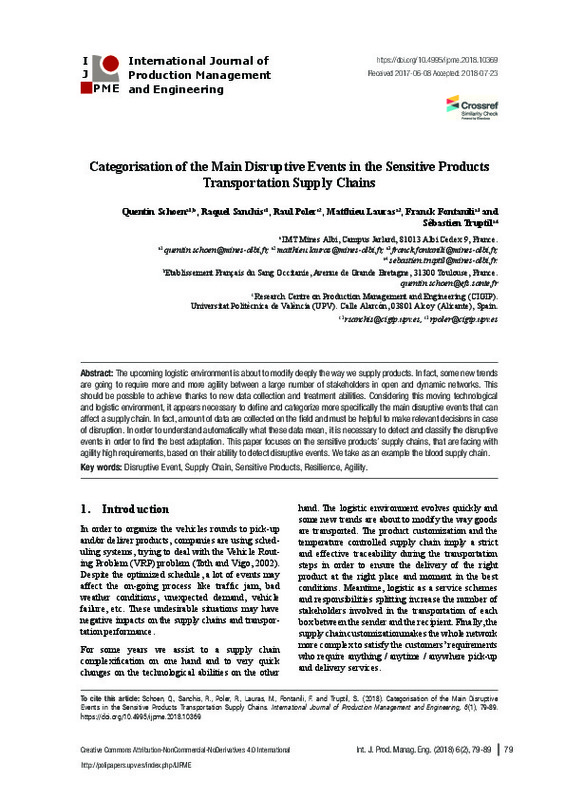Barroso, A.P., Machado, V.H., Machado, V.C. (2008). A supply chain disturbances classification. In Proceedings of the IEEE International Conference on Industrial Engineering and Engineering Management, Singapore. https://doi.org/10.1109/IEEM.2008.4738196
Barroso, H.P., Machado, V.H., Machado, V.C. (2011). Supply Chain Resilience Using the Mapping Approach. Supply Chain Management, Pengzhong Li (Ed.), InTech, Available from: http://www.intechopen.com/articles/show/title/supply-chain-resilience-using-the-mappingapproach.
Barthe-Delanoë, A.M., Lauras, M., Truptil, S., Bénaben, F., Pingaud, H. (2013). A platform for event-driven agility of processes: A delivery context use-case. In Collaborative Systems for Reindustrialization (pp. 681-690). Springer Berlin Heidelberg. https://doi.org/10.1007/978-3-642-40543-3_71
[+]
Barroso, A.P., Machado, V.H., Machado, V.C. (2008). A supply chain disturbances classification. In Proceedings of the IEEE International Conference on Industrial Engineering and Engineering Management, Singapore. https://doi.org/10.1109/IEEM.2008.4738196
Barroso, H.P., Machado, V.H., Machado, V.C. (2011). Supply Chain Resilience Using the Mapping Approach. Supply Chain Management, Pengzhong Li (Ed.), InTech, Available from: http://www.intechopen.com/articles/show/title/supply-chain-resilience-using-the-mappingapproach.
Barthe-Delanoë, A.M., Lauras, M., Truptil, S., Bénaben, F., Pingaud, H. (2013). A platform for event-driven agility of processes: A delivery context use-case. In Collaborative Systems for Reindustrialization (pp. 681-690). Springer Berlin Heidelberg. https://doi.org/10.1007/978-3-642-40543-3_71
Bogataj, M., Bogataj, L., Vodopivec, R. (2005). Stability of perishable goods in cold logistic chains. International Journal of Production Economics, 93, 345-356. https://doi.org/10.1016/j.ijpe.2004.06.032
Brandon-Jones, E., Squire, B., Autry, C., Petersen, K.J. (2014). A Contingent Resource-Based Perspective of Supply Chain Resilience and Robustness. Journal of Supply Chain Management, 50(3), 55-73. https://doi.org/10.1111/jscm.12050
Christopher, M. (2005). Managing risk in the supply chain. In Christopher, M. (Ed.), Logistics & Supply Chain Management, 3rd ed. (pp. 231-58.). Prentice-Hall, Harlow.
Christopher, M., Peck, H. (2004). Building the resilient supply chain. The International Journal of Logistics Management, 15(2), 1-14. https://doi.org/10.1108/09574090410700275
DHL, http://www.dhl.com/content/dam/downloads/g0/about_us/logistics_insights/dhl_logistics_trend_radar_2016.pdf
Harris, I., Wang, Y., Wang, H. (2015) ICT in multimodal transport and technological trends: Unleashing potential for the future. International Journal of Production Economics, 159, 88-103. https://doi.org/10.1016/j.ijpe.2014.09.005
Holling, C.S. (1973). Resilience and stability of ecological systems. Annual Review of Ecology and Systematics, 4, 1-23. https://doi.org/10.1146/annurev.es.04.110173.000245
Kleindorfer, P., Saad, G. (2005). Managing disruption risks in supply chains. Production and Operations Management, 14(1), 53-68. https://doi.org/10.1111/j.1937-5956.2005.tb00009.x
Montreuil, B. (2011). Toward a Physical Internet: meeting the global logistics sustainability grand challenge. Logistics Research, 3(2-3), 71-87. https://doi.org/10.1007/s12159-011-0045-x
Morales Allende, M., Ruiz-Martin, C., Lopez-Paredes, A., Perez Ríos, J.M. (2017). Aligning Organizational Pathologies and Organizational Resilience Indicators. International Journal of Production Management and Engineering, 5(2), 107-116. https://doi.org/10.4995/ijpme.2017.7423
Ponis, S.T., Koronis, E. (2012). Supply chain resilience: definition of concept and its formative elements. Journal of Applied Business Research, 28(5), 921. https://doi.org/10.19030/jabr.v28i5.7234
Ponomarov, S.Y., Holcomb, M.C. (2009). Understanding the concept of supply chain resilience. The International Journal of Logistics Management, 20(1), 124-143. https://doi.org/10.1108/09574090910954873
Ruiz-Martin, C., López-Paredes, A., Wainer, G. (2018). What we know and do not know about organizational resilience. International Journal of Production Management and Engineering, 6(1), 11-28. https://doi.org/10.1108/09574090910954873
Sanchis, R., Poler, R. (2014). Enterprise resilience assessment: a categorisation framework of disruptions. Dirección y organización, 54, 45-53. http://hdl.handle.net/10251/58456
Sanchis, R., Poler, R. (2013). Definition of a framework to support strategic decisions to improve Enterprise Resilience. In IFAC Proceedings Volumes (IFAC-PapersOnline), 700-705. https://doi.org/10.3182/20130619-3-RU-3018.00600
Svensson, G. (2000). Conceptual framework for the analysis of vulnerability in supply chains. International Journal of Physical Distribution & Logistics Management, 30(9), 731-749. https://doi.org/10.1108/09600030010351444
Swafford, P.M., Ghosh, S., Murthy, N. (2008). Achieving supply chain agility through IT integration and flexibility. International Journal of Production Economics, 116(2), 288-297. https://doi.org/10.1016/j.ijpe.2008.09.002
Toth, P., Vigo, D. (Eds.). (2002). The vehicle routing problem. Society for Industrial and Applied Mathematics. https://doi.org/10.1137/1.9780898718515
UN, (1980). United Nations. Convention on International Multimodal Transport of Goods.
Van Meldert, B., De Boeck, L. (2016). Introducing autonomous vehicles in logistics: a review from a broad perspective. Faculty of Economics and Business, Leuven, Belgium.
Wamba, S. F., Akter, S., Edwards, A., Chopin, G., Gnanzou, D. (2015). How 'big data'can make big impact: Findings from a systematic review and a longitudinal case study. International Journal of Production Economics, 165, 234-246. https://doi.org/10.1016/j.ijpe.2014.12.031
Wieland, A., Marcus-Wallenburg, C. (2013). The influence of relational competencies on supply chain resilience: a relational view. International Journal of Physical Distribution & Logistics Management, 43(4), 300-320. https://doi.org/10.1108/IJPDLM-08-2012-0243
[-]








